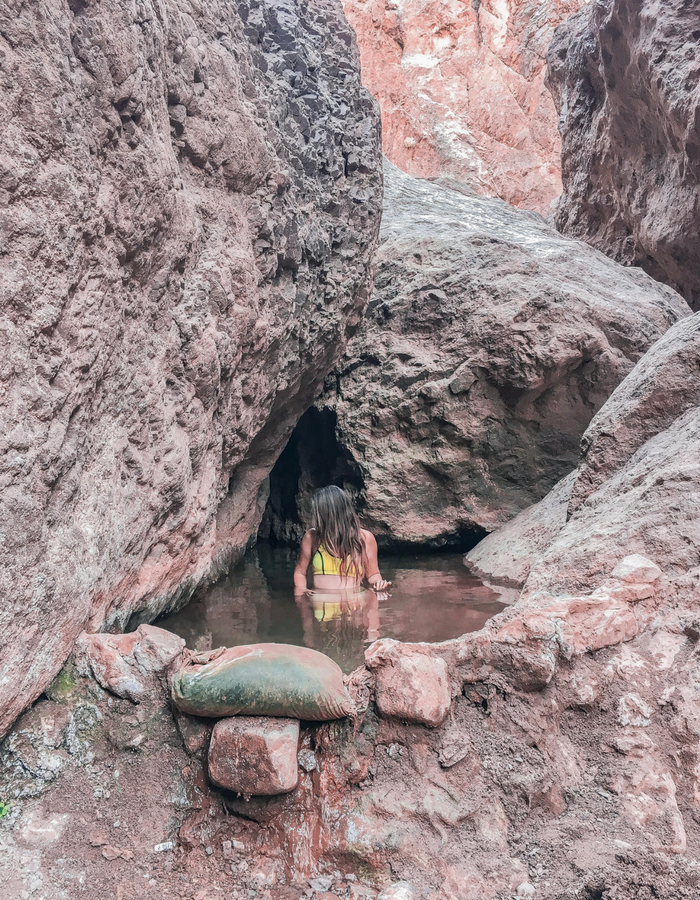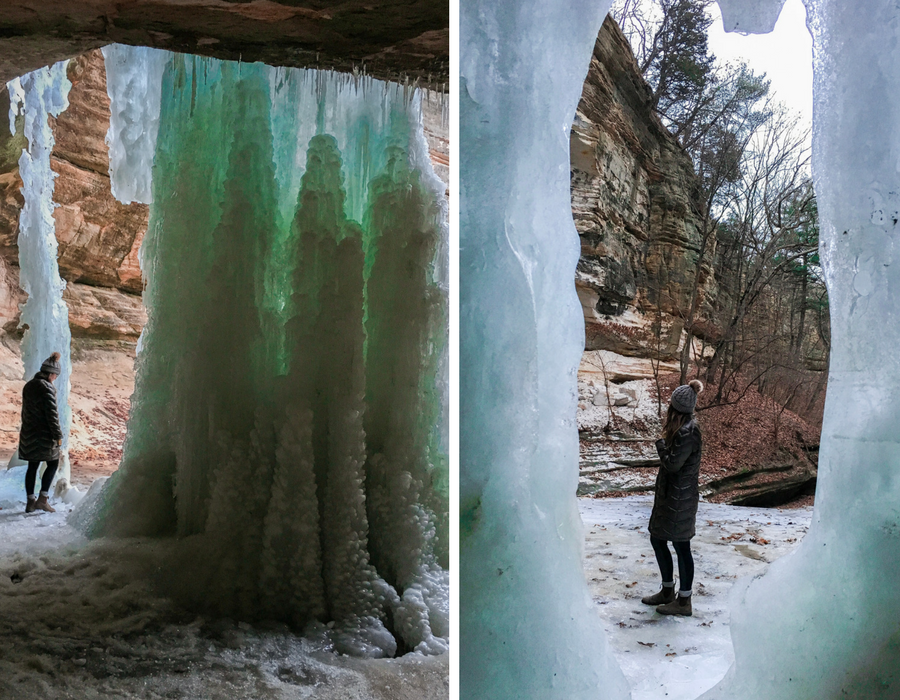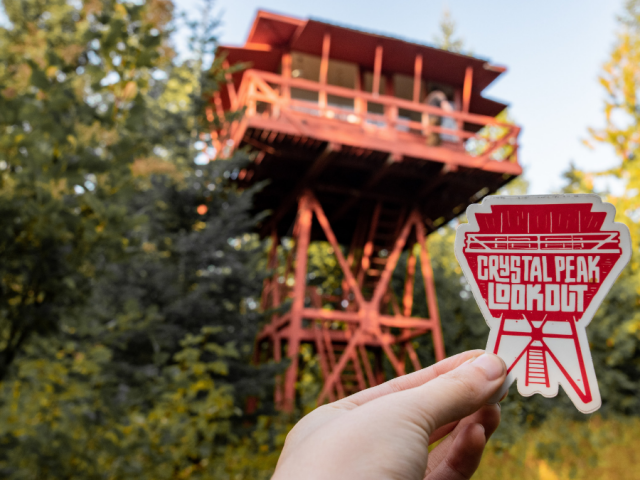Nevada’s lesser-known State Park is truly a hidden gem!
Cathedral Gorge State Park isn’t that far from the incredibly popular Valley of Fire, but because of its remote location it often gets overlooked. Though this park is almost 2,000 acres, it can easily be seen in just one day! In fact, we were able to scope out the best and most scenic hikes, viewpoints, and roadside stops in Cathedral Gorge all before noon!
I know, we’re amazingly efficient. But please, save your applause for the end! Jk.
Prior to planning our 2nd trip to Southern Nevada, I had never even seen photos of Cathedral Gorge. We actually drove right by it on our way back home from the Valley of Fire. To be fair, at the beginning of our ‘wanderlust kick’ we weren’t great at researching or planning… or anything, really. But once I came across a photo of the iconic Miller Point, I was like ‘Wowza’. And it turned out to be the highlight of our trip!
But before we get into all of the best views and hikes that Cathedral Gorge State Park has to offer, let’s quickly go over some important info.

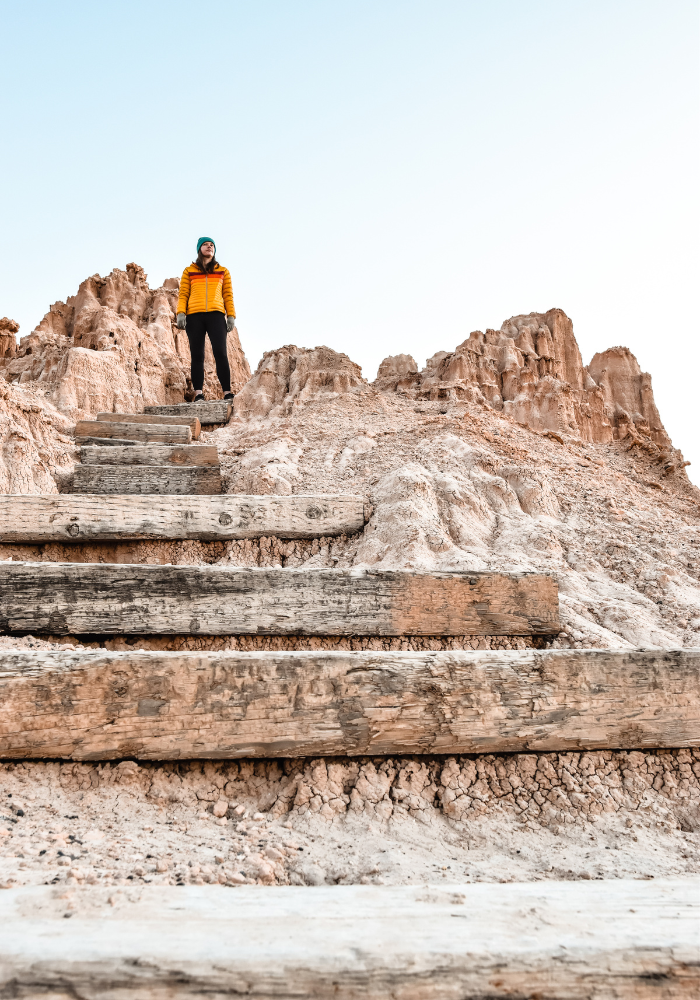

FAQS ABOUT CATHEDRAL GORGE STATE PARK
Are dogs allowed in Cathedral Gorge State Park?
Yes! Dogs are welcome anywhere in the park, but must be kept on a leash. If you’re planning on visiting with your dog, I also included some tips at the end of this post.
Can you fly drones in Cathedral Gorge?
No. Drones are not allowed in the park.
Can I climb on the rock formations in Cathedral Gorge?
While there is no signage prohibiting it, I would highly advise against it! The spires in Cathedral Gorge are made of soft bentonite clay and easily breakable. Plus, there are plenty of cooler photo ops in the park that don’t require off-trail climbing.
What are the best hikes in Cathedral Gorge State Park?
Miller Point Trail. This viewpoint is the most frequently photographed area in the park. It’s stunning!
How was Cathedral Gorge formed?
The unique spires of Cathedral Gorge were formed by years of volcanic activity. After several massive eruptions, the fault fractured and shifted creating the area that is now called ‘Meadow Valley’. The valley filled with water creating a freshwater lake, but over centuries the lake gradually drained and exposed ash and pumice from ancient volcanic activity. The formations in the park are very susceptible to erosion due to water runoff and are STILL changing with every rainstorm.


THINGS TO KNOW BEFORE VISITING CATHEDRAL GORGE
1. There is a Fee to Enter. The fee to enter is $5 for Nevada residents and $10 for non-residents. There is an electronic pay station near the entrance, but it was not working when we arrived.
2. Plan Your Fuel-ups Carefully! It’s important to know that there are very few services on the way to this State Park (regardless of whether you’re driving in from the North or South). There are very long stretches of desert where you won’t see any signs of civilization, so you’ll need to plan when and where you’ll be filling up. There is a gas station just minutes from the state park, but having enough to get there is the bigger issue. We barely made it from Great Basin to Cathedral Gorge – it came down to our last 8 miles!
3. Check the Weather (Especially if you’re bringing your dog). You’ll want to check for rain (the park can get really muddy after rainfall) but really the main concern is going to be heat. This is especially important if you want to bring your dog with you! There is very little shade in the park during the day.
4. Watch for Spikey Plants! I mention this more in my ‘Tips for Bringing Your Dog’ section at the bottom of this post, but there are dry, spikey plants along the trails that you’ll need to watch for. I don’t know the name of the plant, but they are the building blocks for tumbleweeds (hopefully that helps you visualize it!). If I were to visit again with my dogs, I would definitely put booties on them! The stupid spikey seeds got stuck in their feet more than a few times, even though they were leashed and on-trail.
5. Bring Clean Water + Food. There are very limited options for food nearby. Potable water is available at the entrance of the park, but I definitely recommend bringing your own! You never know when services will or won’t be available.
6. Bathrooms. There are bathrooms at the campground, as well as a bathroom next to the picnic area (at the Miller Point and Juniper Draw trailhead).
The Best Hikes and Stops in Cathedral Gorge State Park

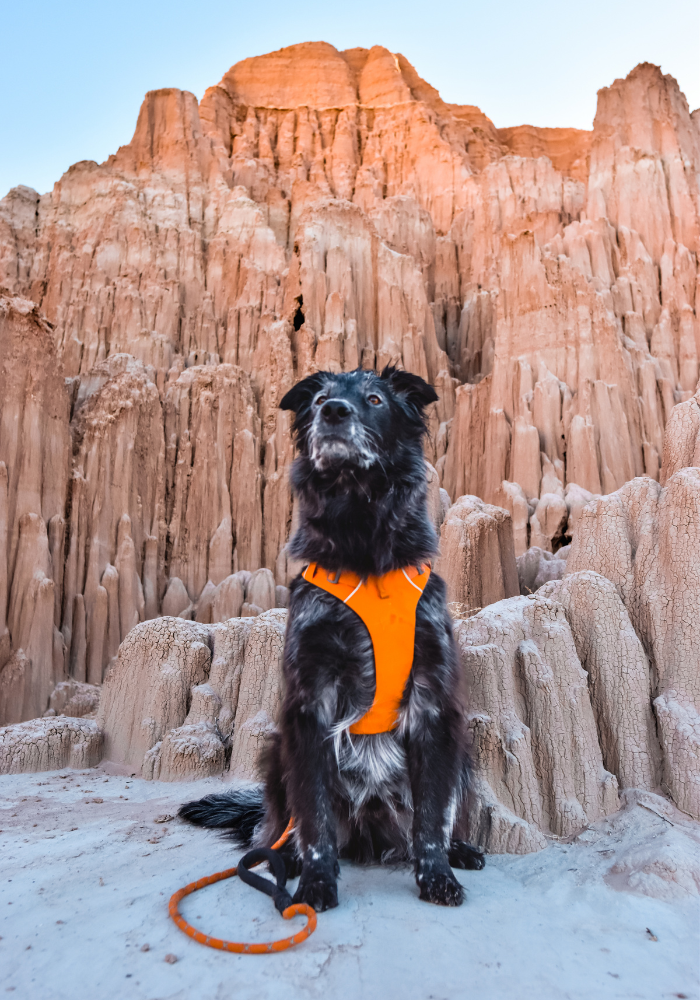
1. Moon Caves
TRAIL INFO
Distance: 0.2 Mile
Elevation: 26 Feet
Difficulty: Easy
Trail Type: Out & Back
Once you enter the park, the very first thing you’ll see (to your right) are the Moon Caves. There are 3 different ‘caves’ in Cathedral Gorge, but caves is a bit of a misnomer. They are more like slot canyons. Still hugely interesting, though!
The views from inside the caves are cool but the sights on the outside are, in my opinion, even more scenic! The bentonite spires of Cathedral Gorge are what makes this state park so iconic, and Moon Caves is one of the best hikes for capturing their beauty.


2. Canyon Caves
Up next you’ll find Canyon Caves (also on your right). You can drive from Moon Caves to Canyon Caves, but honestly it isn’t necessary. They are VERY close neighbors. Like ‘turn your TV down, we share a wall’ close.
There is no trail info for the hikes to Canyon or Cathedral Caves (coming up on this ‘best of’ list) but they are really only steps from the main Cathedral Gorge road.
Out of the 3 caves, we spent the most time at Canyon Caves – but not for any real reason. They are all very similar, but particularly Moon Caves and Canyon Caves. Both of these areas have a natural curvature, like an amphitheater, that allows you to take sweeping photos of the bentonite spires.


3. C.C.C. Water Tower
The historic water tower can’t honestly be labeled a ‘hike’ considering it is just off the main park road, but it is still worth checking out! You can’t go inside, but Francis managed to snap the above photo by sticking his iPhone through the bars.
The water tower was constructed in the 1930’s but later capped and abandoned due to the high alkali content of the water.
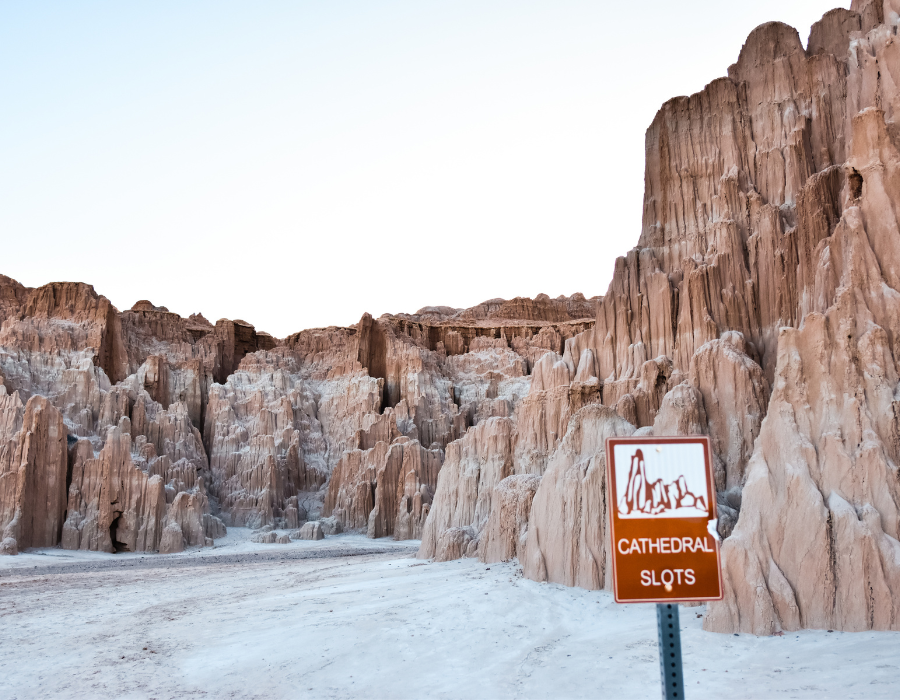
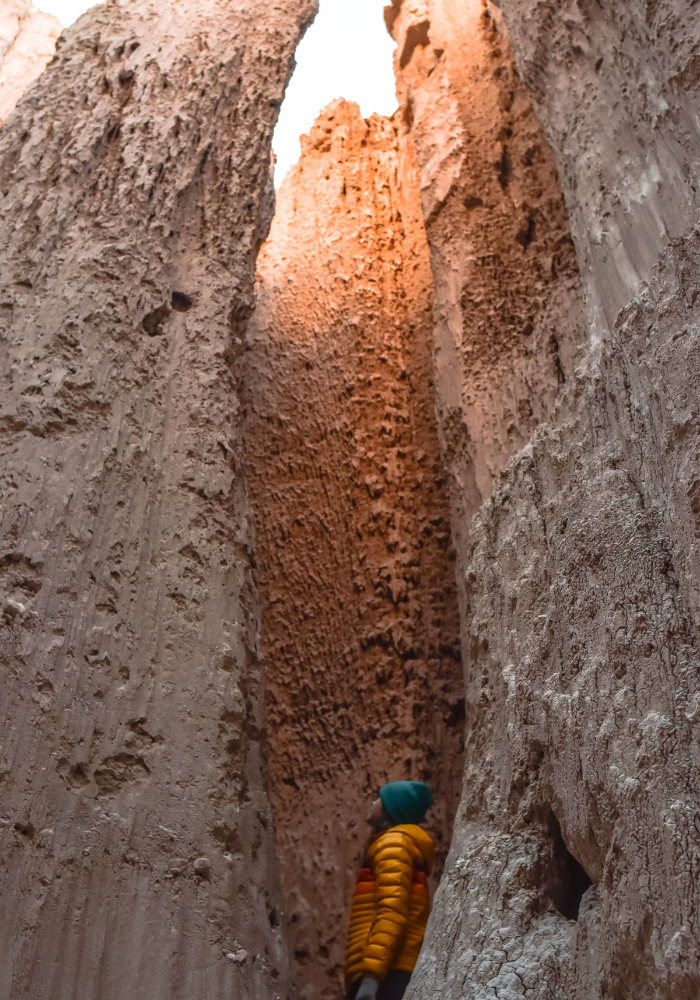

4. Cathedral Caves
At the end of the road, you’ll find the C.C.C. Picnic Area, public bathrooms, the main trailhead junction, and the Cathedral Caves. This is the 3rd and final ‘cave’ area in the park.
As I mentioned above there is no official trail info for the Cathedral Caves, but they are so close to the road that it’s not really worth pacing out. Calling the caves ‘hikes’ is a bit of a stretch, but they really are the best way to get a close-up look at Cathedral Gorge’s unique geology!
Once you’re done exploring, this is a great place to rest before starting out on your first real hike! There are bathrooms right next to the caves and the picnic area has plenty of seating.


5. Juniper Draw Loop Trail
TRAIL INFO
Distance: 3.3 Miles
Elevation: 216 Feet
Difficulty: Easy
Trail Type: Loop
Juniper Draw Loop Trail is one of few actual “hikes” in Cathedral Gorge – it’s also the longest trail and the best way to stretch your legs during your visit! You can easily combine this hike with the Nature Loop Trail as about 70% of the Nature Loop is included in Juniper Draw.
The trail begins next to the picnic area, and you’ll want to keep left at the fork for Juniper Draw. The trail to the right takes you to Miller Point. The loop will take you North into the valley, then back down past the campground where you’ll link up with the Nature Trail.
NOTE: Miller Point Trail (listed below) is not technically part of this trail, but many people take the out & back trail to Miller Point either at the beginning or the end of their loop hike.



6. Miller Point Trail
TRAIL INFO
Distance: 0.5 Mile
Elevation: 111 Feet
Difficulty: Easy
Trail Type: Out & Back
If you only have time for ONE hike, Miller Point is the one to choose! The trail is short, but expect to spend a lot of extra time photographing the area. There are tons of great viewpoints before you even reach the top of Miller Point. In my opinion, this is the best of the Cathedral Gorge hikes!
As mentioned above the trail begins at the picnic area, but instead of heading left at the fork (for Juniper Draw) you’ll keep to the right. After that, the trail is pretty straightforward all the way up to the lookout.
NOTE: Many dogs are reluctant to walk up stairs like these (Chewy had a bit of a hard time at first) and some dogs won’t be able to comfortably walk on them at all if their paws are too small. I mention this in more detail in my “Tips for Visiting With Dogs” section at the bottom of this post, but just keep that in mind if you’re planning a visit with your pup!



7. Eagle Point Trail
TRAIL INFO
Distance: 1 Mile
Elevation: 75 Feet
Difficulty: Easy
Trail Type: Out & Back
Eagle Point Trail begins just off of Miller Point Road, but there are 2 ways to access the trail:
- Drive up to Miller Point Rd (just off of US-93) and park in the designated area.
- Hike the Miller Point Trail all the way up to the overlook, then continue up the road a little ways to the trailhead.
Either way, if you’re already hiking Eagle Point, I highly recommend stopping at the Miller Point Overlook. It’s just a short walk from the Eagle Point trailhead and is probably the most iconic view in the park!
The Eagle Point trail is ideal if you’re looking for expansive views of the valley below. Miller Point offers some amazing views of the cool spires that Cathedral Gorge is famous for, while Eagle Point showcases more of the actual open valley. In my opinion, Miller Point is a more interesting view, but they are both gorgeous in their own way!
8. Nature Loop Trail
TRAIL INFO
Distance: 0.6 Mile
Elevation: 22 Feet
Difficulty: Easy
Trail Type: Loop
The Nature Loop is a flat trail that cuts through the valley and is a convenient way to get from the State Park campground to the main area of the park. Honestly, as far as views go, this isn’t going to be a hot contender. It may not be in the top 3 Cathedral Gorge hikes, but if you’re camping in the park it’s an easy and quick way to get to all of the park’s best trails!


TIPS FOR VISITING CATHEDRAL GORGE WITH YOUR DOG
1. Bring the Proper Supplies.
There are a few things I’d recommend bringing to make your trip to Cathedral Gorge fun for you and your best friend:
- Leash and harness / collar (required)
- Poop bags
- Plenty of water + a collapsible bowl
- Booties (I’ll get into this more in the next section)
2. Watch out for these Paw Hazards!
If you are able to, I’d definitely recommend packing some dog booties! But if not, be sure to do the ‘ground test’ by holding the back of your hand in the sand for 7 seconds to check the temperature. If it’s too hot to hold your hand on, it’s too hot for your dogs paw pads.
You’ll also want to watch for these brutal plants (pictured below). They drop spikey seeds and they got stuck on our dogs little feet more than once! If we ever visit again, I’m definitely busting out the dog booties.
3. Skip the Stairs (and the Heights!)
Some dogs are afraid of stairs – and some of the stairs up to Miller Point are particularly sketchy. If your dog isn’t able to walk up the metal stairs – OR if you aren’t comfortable with the steep drop-offs – there is also a Miller Point access road off of US-93 that takes you directly to the viewpoint.
NOTE: If you really want to take the stairs and you have a smaller dog, you may have to carry them to avoid their little paws getting stuck and / or injured.
4. Don’t Overdo It!
The park has almost zero shade, so don’t push your dog too far AND bring a vehicle with functioning air conditioning. In warmer months, I’d recommend visiting early in the morning. We visited at first light in early April and it was cold enough for a winter jacket, so our floofy dogs were in their ideal environment!


Extending Your Trip? There’s More to See in Nevada!
Looking for more State Parks? Check out Nevada’s Valley of Fire!

Heading to Vegas? Find outdoor adventures near the city!

Interested in desert hot springs? Discover Gold Strike Hot Spring!
